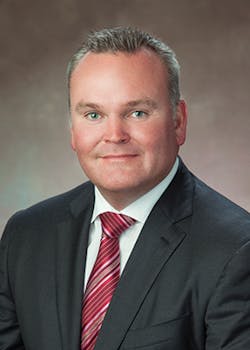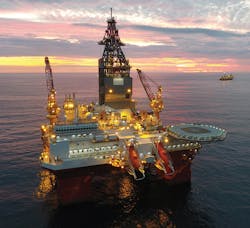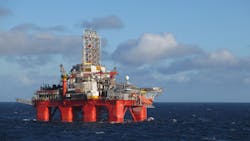Transocean CEO: Offshore drilling market picking up
Bruce Beaubouef
Managing Editor
Buoyed by higher prices and growing demand, the offshore drilling market – one of the downturn’s hardest hit segments – may be on the upswing. That is the view of Jeremy D. Thigpen, CEO of Transocean Ltd., who says his company embraced the capital efficiencies necessitated by the downturn.
Transocean high-graded and differentiated its fleet through rig retirements and the addition of high-specification assets targeted to the harsh environment and ultra-deepwater markets, which Thigpen expects to be the most active in the near-term, and beyond.
Recently, Thigpen, who joined Transocean in 2015, met withOffshore.He shared views on Transocean’s acquisitions and divestitures; the company’s lowering of costs and addition of value for customers; and the outlook for the offshore drilling market.
Thigpen
•••
Offshore: Describe the current offshore drilling market?
Thigpen: It’s the first time in three years I’ve had some optimism. The harsh environment market is exciting. With demand increasing for high-specification, harsh environment semisubmersibles and only a few assets available, day rates are starting to appreciate. You go back 12 months, and these asset fixtures were being signed at $150,000/day. Fast forward to the most recent fixture signed at $320,000/day plus bonus based on performance; that takes you up to $350,000 to $360,000/day.
The primary driver of demand in the North Sea is the low break-even costs our customers have established. In an environment where Brent crude is bouncing around $70 per barrel, the economics for our customers are very compelling.
While I would not classify it as exciting yet, I’m encouraged by the ultra-deepwater market – the other market we primarily participate in. This includes the Gulf of Mexico, certain parts of South America, certainly Brazil, and West Africa. Activity is starting to pick-up across multiple basins; and, importantly, it’s being driven by the majors, who are now starting to look across their portfolios of assets as they make capital allocation decisions heading into 2019.
Offshore: Which geographic markets do you see as the most promising for Transocean?
Thigpen: I would start with Norway. The UK sector of the North Sea would be next. The Mexican portion of the Gulf of Mexico is very interesting. With recent foreign investment, we have several customers who are anxious to initiate campaigns offshore Mexico. We think there’s going to be quite a bit of opportunity there over the next two years.
Brazil is also interesting. There could be something on the order of 40 rigs operating off Brazil in two to three years. We’re also seeing opportunities surface in West Africa, India and Australia.
Offshore: Tell us about the rigs operators want to employ, and how Transocean is meeting those demands?
Thigpen: As we typically see in a downturn, our customers are demanding the highest specification assets, because they can secure them for the same rate as a lower specification asset. The silver lining is our customers are exposed to the most efficient assets in the world, and they see the difference in their well construction costs.
That’s where our newest rigs come in. We have added five new ultra-deepwater drillships, each on long-term contracts, that are among the best assets in the world. We’ve also added four new, harsh environment Cat D rigs that we acquired from Songa Offshore.
Additionally, we have two drillships under construction that we upgraded to offer three million-pound hookloads. They will be the only two rigs with this hoisting capacity. When you put all of that together, that’s 11 brand new assets to offset the 43 floaters we have scrapped to date; but we want to continue to high-grade the fleet as we move forward.
TheSonga Encourageis one of Transocean’s four new harsh-environment rigs working offshore Norway. (All images courtesy Transocean)
Offshore: Reports indicate Transocean is now able to drill wells faster and more efficiently. What’s enabling this?
Thigpen: It’s a combination of factors. One would be asset quality. These higher-specification assets, our best assets, are now operating on behalf of our customers. But in addition to high-grading our fleet, we’ve high-graded our crews by keeping our experience in-house and further equipping our crews with resources and technology that improve efficiency, including the Performance Dashboard application we launched last year.
As the most experienced offshore drilling contractor in the industry, we have drilled for every customer in every major basin, accumulating troves of data. In the past, we did not fully utilize the data to drive continuous performance improvement. Today, through the direct input of some of our most seasoned drillers and rig managers, we harnessed that data and developed an intuitive dashboard to track how each rig, and crew is performing against top-quartile performance in each phase of the well construction process. Whether tripping, running riser, testing BOPs, or building BHAs, we and our customers can easily monitor rig and crew performance. Our customers appreciate the transparency, and new ways we use the data to improve our performance for them.
Offshore: You mentioned that Transocean has retired 43 rigs. Going forward, how will you determine which additional rigs you will retire, if any?
Thigpen: We’ve demonstrated our commitment to high-grading our fleet by retiring 43 floaters. Once a quarter, we revisit the macro environment, and update our assumptions on the market direction, future rig demand, day rates, and customer preferences. We then re-evaluate our stacked fleet and update our plans and financial models for asset reactivation.
It’s important to note we make an upfront investment to properly preserve our equipment as we stack each rig. So, if we have a rig stacked today, it’s because we believe that rig is going to be marketable in the future. However, if, through our quarterly discussions, we find that our outlook or assumptions have changed, we will retire a currently stacked asset. We did this recently with theDeepwater Discovery, Deepwater Frontier and Deepwater Millennium.
On the topic of stacking and recycling, due to our preservation techniques, we have successfully reactivated five rigs. Two were cold stacked. The other three were warm-stacked or idle. Thus far, the reactivation of the equipment has gone almost flawlessly. On a go-forward, depending on the trajectory of the recovery, our biggest challenge will not be the reactivation of assets; instead, it will be the reactivation of crews. As an industry, we have downsized during the past three years. Some have gone on and found other jobs. Attracting them back is going to be a challenge for the entire industry.
Top: The harsh-environment semisubmersibleTransocean Norgewill be available for work in 1Q 2019. Bottom: The harsh-environment semisubmersibleTransocean Spitsbergenis working for Equinor in the Norwegian North Sea.
Offshore: Last May, Transocean sold its jackup fleet. Can you share the rationale for exiting the jackup market?
Thigpen: To be clear, we were not a big player in jackups. We had 10 jackups in our fleet and we had five more under construction. Those five jackups carried a $1 billion capex in 2019/2020. Given the uncertainty in the market, at the time, removing that capex obligation was an important consideration.
Ultimately, selling the jackups was a strategic decision given our desire to focus on Transocean’s strengths in the harsh environment and ultra-deepwater markets. We believe in ultra-deepwater and harsh environment, our asset quality, our technical expertise, our operational performance, our experience – everything we’ve talked about – helps differentiate Transocean in the eyes of our customers. We did not see the same opportunity in jackups.
Offshore: Another notable deal for Transocean was the acquisition of Songa Offshore. Can you talk about the acquisition drivers, and expected benefits?
Thigpen: When I joined Transocean in 2015, there was a lot of discussion about what to do with certain rigs. Do we keep them in perpetuity, and hold onto the option value? Do we sell them to our competitors? Do we package some together and spin them out as a separate company? Do we scrap them? Do we upgrade them?
We decided to take a pragmatic, data-driven approach to evaluate our fleet. To accomplish this, we built two databases – one for ultra-deepwater and one for harsh environment. We then inputted the primary technical specifications for every rig in the world – even those in shipyards under construction – and we force-ranked every asset based on its technical qualifications. The process helped us to objectively assess our rigs compared to the global fleet, and enabled us to quickly identify assets we should recycle.
Once we identified the scrap candidates, we evaluated our marketable assets. We asked: ‘Can we invest a little capital and make them even more marketable?’ As you might expect, we found several candidates, including theDiscoverer India, which we recently upgraded. We invested approximately $15 million, moving her up to within the top 50 assets in the world.
This rig-ranking database also helped to identify acquisition targets. As we looked at the harsh environment rig database, Songa Offshore screened well. Although they had three rigs lower on the rig ranking, they had four brand new Cat D semisubmersibles that ranked very high, so we decided to take a closer look.
We liked what we saw: high-quality assets, solid backlog, a long-standing presence in the strengthening market of Norway, and a great relationship with a strategic customer – Equinor. It just ticked all the boxes.
Offshore: In the drive to lower cost and improve capital efficiency, what has Transocean done to help its clients?
Thigpen: We first looked to lower costs within our system to be more profitable at lower day rates. Our customers and investors demand that today. Among the steps we took was to use historical data, specifically related to our maintenance activities, to better understand how we crew a rig. We realized, if we better planned our maintenance activities, and other rig activities, we could maintain operating performance with reduced personnel.
We also entered into what we call OEM health care agreements, where we take a more collaborative approach with our original equipment manufacturers to monitor equipment health, and perform maintenance as and when needed, as opposed to according to a calendar. These agreements help us to further improve equipment uptime performance, while reducing maintenance costs.
Aside from that, the biggest way we help our customers is by drilling more efficiently, which we are doing with our Performance Dashboards and other proprietary technologies.
Offshore: What are your views on the near-term market and the market further out?
Thigpen: Assuming oil prices remain constructive, we expect continued activity in the North Sea. Our confidence in this part of the world led to our recent investment in the technically advanced, harsh-environment semisubmersible, West Rigel, recently renamed the Transocean Norge, which will be available to work after emerging from the shipyard in late 2018.
We also expect incremental activity in the ultra-deepwater market late this year and into 2019. If Brent remains in the $60 to $70 per barrel range, our customers should enter 2019 with more project optimism. This should lead to increased utilization, and then day rate appreciation in ultra-deepwater toward the back half of 2019 into 2020. If past cycles are an indicator, this may move more quickly than many expect.
Like we saw in Norway, there could be a situation where our customers try to secure the best assets all at once. If we use harsh environment as the proxy, day rates could double in a short period of time. Maybe I’m being overly optimistic, but it behooves a company like Transocean to be prepared for the increased demands of a market uptick. So, in a real sense, being optimistic is a key part of being prepared.




